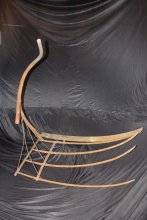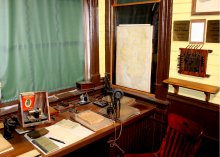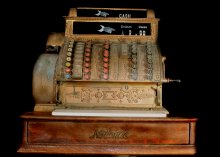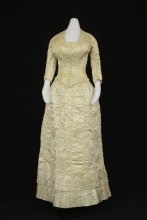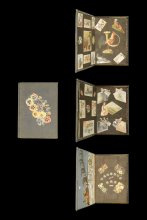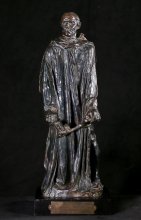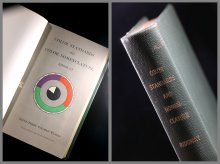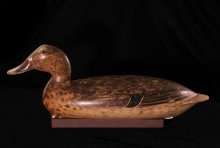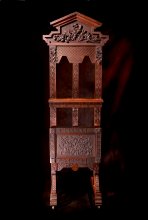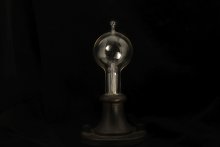Industrializing Illinois (1877-1917)
Following the Civil War, Illinois continued to grow in population, diversity, and complexity. Large-scale heavy manufacturing and a growing commercial sector joined agriculture as major employers of a rapidly growing population. Immigration continued, with African Americans from the South and southern and eastern Europeans joining more established groups. Conflicting interests sometimes led to unrest, strikes, and even violence. During this period, Illinois also became a center of exciting new movements in art, architecture, and literature.
A cradle reaper was used to cut crops such as wheat, oats, and hay and then rake the cut crop into a single row. Pitchforks would then be used to throw the harvested crop into a wagon to be hauled to the farmer's barn for storage. This particular cradle reaper was used on the Snipe Hollow Farm near Elizabeth, Illinois, sometime in the late 1800s.
The telegraph, invented by Samuel F.B Morse in 1844, opened nearly instant communication with the wider world, and railroads quickly lined their tracks with telegraph poles, continuing to use this infrastructure long after later inventions such as the telephone were commonplace. Today, a train's diesel horn still sounds the letter 'Q' in Morse code at all grade crossings: dash, dash, dot, dash.
From its opening in 1905, O.M. Bishop called his store "The Busy Big Store," advertising five departments (clothing, shoes, groceries, variety, and dishes) under one roof. On the second floor, the biggest theater in the county at its opening, the Lyric Theater, showed movies from 1916-1931. This space also served as a community meeting house where dances, suppers, vaudeville shows, graduations, and even roller skating took place.
Miss Fanny Matheny wore this dress when she graduated from the Bettie Stuart Institute in Springfield at age 19. The Bettie was a girls’ school that educated the daughters of some of Springfield’s most prominent families in courses ranging from English and math to art and music. After graduation, Fanny married Dr. John Dixon and played an active role in the city’s cultural and charitable organizations. She was involved in the Humane Society, the Red Cross, and the Home for the Friendless.
Twenty-five-year-old Rosa Dietz Hubbard of Mason City assembled this scrapbook in 1891 from colorful trade cards, scraps, and greeting cards.
This sculpture was a gift to the people of the State of Illinois from French vermouth producer Noilly-Prat. This was one of many gifts packed into vintage railway box cars known as the Merci Train, or French Gratitude Train, of 1949. The purpose of this gift was to acknowledge the more than $40 million in food and aid collected in 1947 by private citizens in the United States and sent to France and Italy after World War II.
Combining science and art, ornithologist Robert Ridgway tried to bring scientific order to the description of the colors of birds. When he published this Color Standards and Nomenclature in 1912, it was actually his second version. The first one, Nomenclature of Colors for Naturalists, published in 1886, included hand-colored plates.
This decoy of a mallard hen was carved by Robert Elliston (1847-1925), one of the earliest commercial decoy makers and widely considered to be the father of the Illinois River decoy carving tradition. In 1882, Elliston began creating lightweight, realistic decoys for the sportsman who visited the Undercliff Hotel in Putnam County, a popular hunting spot along the Illinois River flyway. His wife, Catherine, painted the ducks with realistic patterns that were soon copied by other painters.
This home easel would have been used in a Victorian parlor to showcase paintings, drawings, prints, or other framed items. A functional piece of furniture, the easel is also a work of great artistry, elaborately hand-carved with stylized floral motifs.
Thomas Edison and Nikola Tesla were engaged in a heated rivalry (known as the War of the Currents) to see whose invention would ultimately be adopted by the world at large. The first light bulb pictured here is a model of the first incandescent bulb invented by Thomas Edison. It ran on direct current (DC), a current of electricity that runs continuously in a single direction. While DC was standard in the United States in the early years of electricity, it could not easily be converted to higher or lower voltages. Nikola Tesla solved that problem by developing alternating current (AC), which could easily be converted to different voltages using a transformer.
Pages






